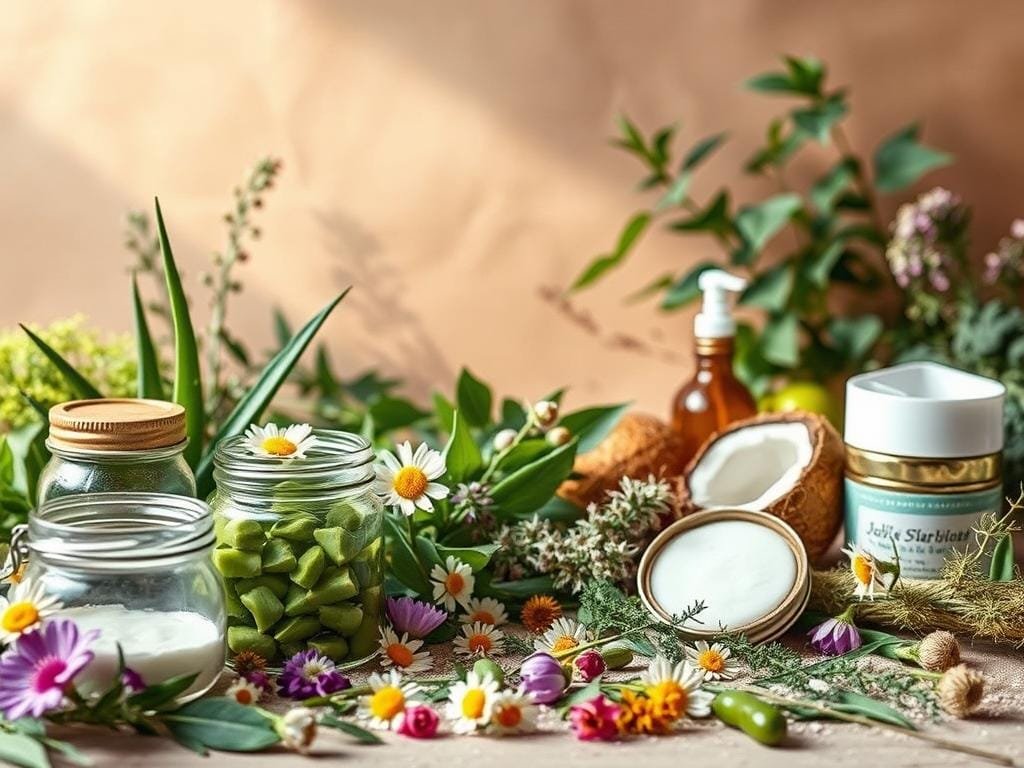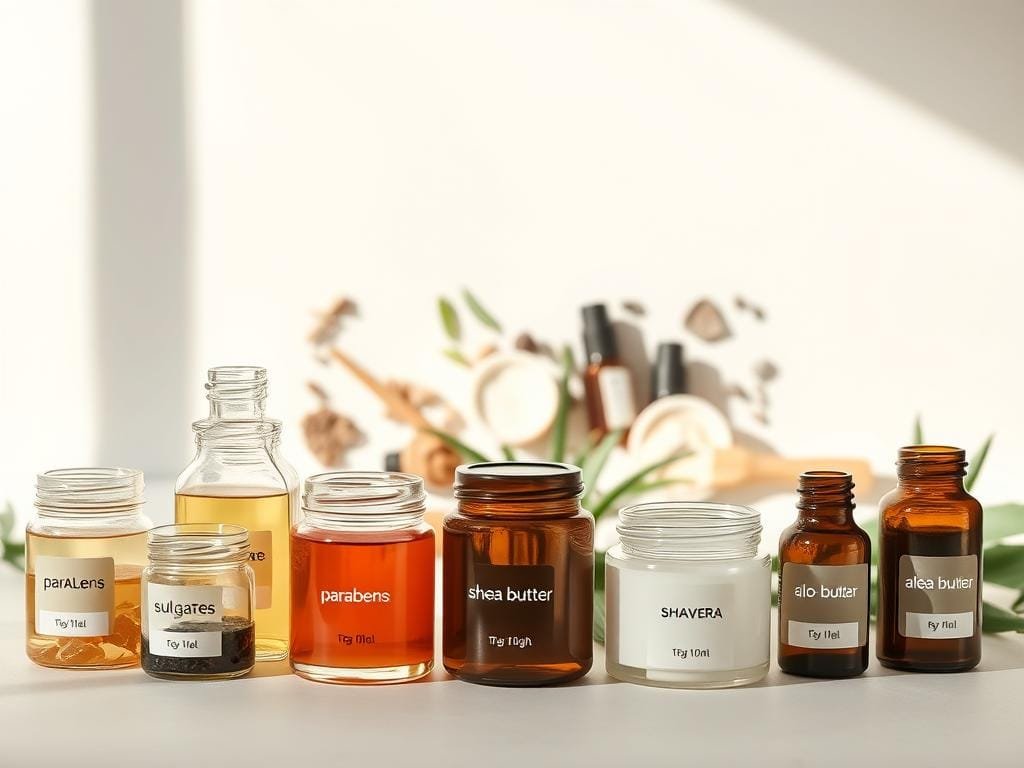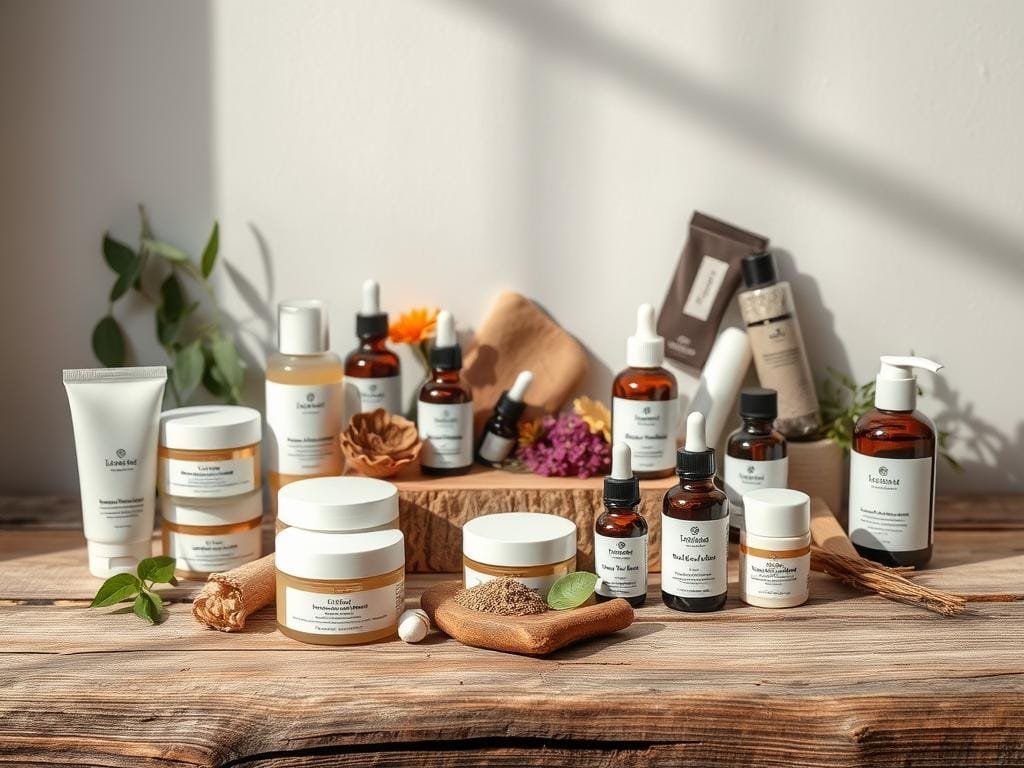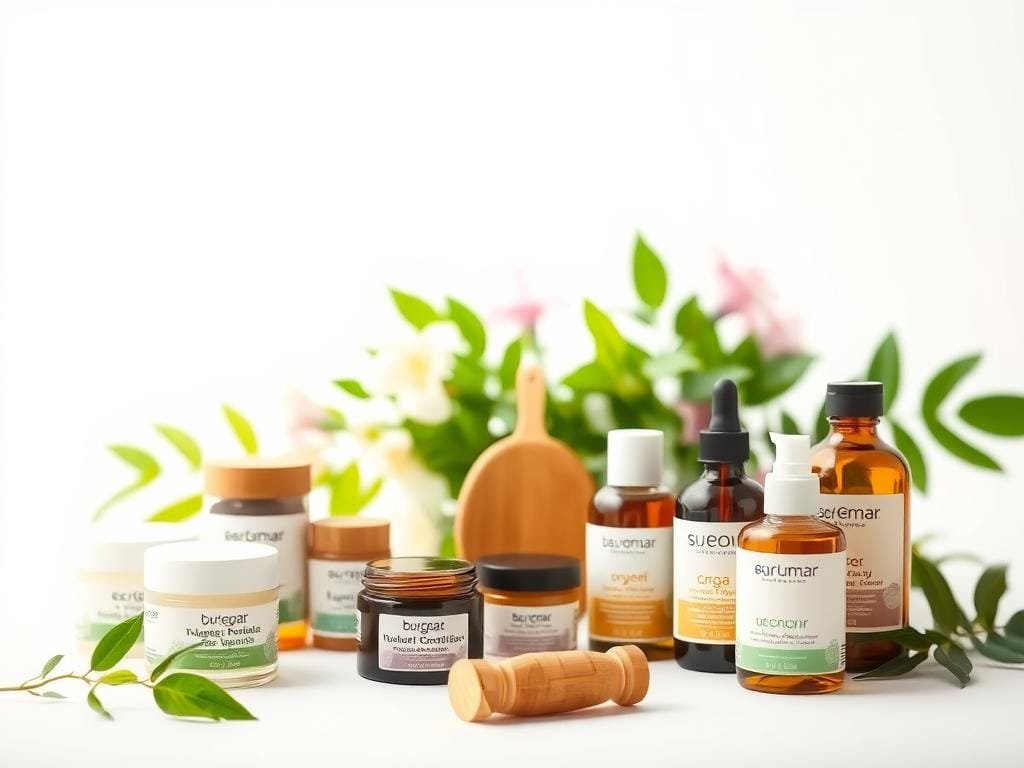Did you know the average person absorbs nearly 5 pounds of skincare chemicals each year? With the rise of non-toxic skincare, knowing what’s in your products is key. Skincare labels tell you about ingredients, how much is in them, and what they’re for. But, they can be hard to understand.
Learning to read these labels helps you make smart choices for your skin and health. Some ingredients, like parabens and sulfates, can be harmful. On the other hand, natural ingredients like plant oils and botanical extracts can be good for your skin. Check out our guide on natural skincare to find out more about safe and effective ingredients.
Table of Contents
Key Takeaways
- Understand the importance of reading skincare labels carefully.
- Identify harmful ingredients to avoid in your skincare products.
- Discover natural ingredients that provide hydration and nourishment.
- Learn how to make informed decisions about your skincare routine.
- Explore the benefits of non-toxic skincare for your overall health.
What is Clean Beauty?
Clean beauty focuses on transparency, integrity, and quality natural ingredients. It’s about choosing products that are good for your skin and the planet.
Understanding the Concept
Clean beauty is more than a trend. It’s a choice to use non-toxic and environmentally friendly products. People are now more aware of what they apply to their skin and its effects on health and the environment.
The main idea is to avoid harmful chemicals. Instead, choose organic beauty products with natural ingredients. This not only helps your skin but also supports the planet.
The Importance of Clean Ingredients
Using clean ingredients is key for healthy skin. Natural ingredients are less likely to irritate and are better for you in the long run. Here’s a look at traditional vs. clean beauty products:
| Product Type | Ingredients | Benefits |
|---|---|---|
| Traditional Beauty Products | May contain harsh chemicals, synthetic fragrances, and dyes | Quick fixes, but may harm in the long run |
| Clean Beauty Products | Rich in natural ingredients, non-toxic, and good for the environment | Helps keep your skin healthy and supports sustainability |
Choosing clean beauty products benefits your skin and the planet. Clean ingredients are essential for a healthy skincare routine.
Common Myths About Clean Beauty
The clean beauty movement has faced many misconceptions. It’s important to clear up these myths. This way, we can understand what clean beauty really is.
Misconceptions Debunked
One myth is that clean beauty products don’t work as well. But, many clean beauty brands use high-quality, sustainable ingredients. These ingredients are often as good, or even better, than those in regular beauty products.
Another myth is that clean beauty is too pricey. While some clean beauty items might cost more, there are affordable choices too. You can find cruelty-free makeup and sustainable cosmetics at different price levels. This makes clean beauty more accessible to everyone.
- Clean beauty is not just a trend; it’s a movement towards more conscious consumerism.
- Many clean beauty brands are committed to sustainability and reducing environmental impact.
- Cruelty-free and vegan options are becoming increasingly popular in the clean beauty space.
The Role of Marketing
Marketing has a big impact on how we see clean beauty. Sometimes, marketing can make us think things that aren’t true. It’s important to look beyond what’s said in ads and really understand what’s in the products and what the brand stands for.
When you’re looking for clean beauty products, check the labels and ingredient lists. Watch out for greenwashing. This is when brands say they’re sustainable or clean but don’t really follow through.

By knowing the truth about clean beauty, you can make choices that fit your values and needs.
Key Ingredients to Look For
Identifying the right ingredients is key for clean beauty. It’s not just about avoiding harmful chemicals. It’s also about using products with beneficial ingredients.
Natural Oils and Butters
Natural oils and butters are essential in clean beauty. They moisturize and nourish the skin. Coconut oil, shea butter, and argan oil are great for hydrating and protecting.
These natural emollients keep moisture in, soothe dry skin, and improve elasticity.
Antioxidants and Vitamins
Antioxidants and vitamins are vital in clean beauty. They protect the skin from environmental stressors and promote health. Vitamins C and E, along with green tea extract, fight free radicals and reduce aging signs.
For more info on beneficial ingredients, check out this resource.
Plant-Based Extracts
Plant-based extracts are a key part of clean beauty. They offer benefits like soothing, calming, anti-inflammatory, and regenerative effects. Aloe vera, chamomile, and calendula soothe irritated skin.
On the other hand, turmeric and ginger have anti-inflammatory properties.
Choosing clean beauty products with these ingredients helps you get healthier, more radiant skin. It also supports green beauty and vegan skincare principles.
Ingredients to Avoid in Clean Beauty
To fully embrace clean beauty, knowing what to avoid is key. It’s important to understand the ingredients that can harm your skin and health. This knowledge helps you make better choices for your beauty routine.
Harmful Chemicals
Many beauty products contain harmful chemicals. These can cause skin irritation, allergic reactions, and health problems. It’s vital to know about these chemicals to choose safer options.
For more info on the dangers of toxic beauty ingredients, check out this resource.
Synthetic Fragrances
Synthetic fragrances can irritate the skin and cause allergic reactions. They’re often found in perfumes and scented products. Always check the ingredient list to avoid them.

Parabens and Sulfates
Parabens and sulfates are common in traditional beauty products but should be avoided in eco-friendly beauty routines. Parabens can disrupt hormones, while sulfates dry out the skin. Choosing products without these ingredients is better for your skin.
By avoiding these ingredients, you can keep your beauty routine in line with clean beauty principles.
How to Read Clean Beauty Labels
To choose the right skincare, you need to understand clean beauty labels. It might seem hard at first, but knowing what to look for is key. By checking certifications, ingredient lists, and avoiding certain terms, you can pick safe, non-toxic products.
Deciphering Certifications
Certifications help you know if a product is trustworthy. Look for USDA Organic or Leaping Bunny labels. These show the product is natural and cruelty-free. For more tips, check out The Ultimate Guide to Understanding Beauty.
| Certification | Description |
|---|---|
| USDA Organic | Indicates that the product contains a high percentage of organic ingredients. |
| Leaping Bunny | Signifies that the product is cruelty-free and has not been tested on animals. |
| ECOCERT | A certification that ensures the product meets environmental and social standards. |
Understanding Ingredient Lists
Ingredient lists can be confusing, but knowing what to look for is important. Choose products with natural ingredients and avoid harsh chemicals. The first few ingredients are the main part of the product.
- Look for natural oils and butters that moisturize and nourish the skin.
- Be aware of antioxidants and vitamins that help protect the skin.
- Plant-based extracts can offer various benefits, from soothing to anti-aging.
Recognizing Problematic Terms
Some terms on labels can be tricky or mean harsh chemicals. Watch out for synthetic fragrances, parabens, and sulfates. These can irritate your skin or harm your health. Knowing these terms helps you make better choices.
- Synthetic fragrances can cause allergic reactions and skin irritation.
- Parabens have been linked to hormone disruption.
- Sulfates can strip the skin of its natural oils, leading to dryness.
Clean Beauty vs. Traditional Beauty: What’s the Difference?
When you explore beauty products, knowing the difference between clean beauty and traditional beauty is key. The main difference is in the ingredients and the philosophy behind each.
Ingredient Comparison
Clean beauty uses natural, non-toxic ingredients that are kind to your skin and promote health. Traditional beauty products, on the other hand, often have synthetic chemicals that can be tough and harmful. Clean beauty products often include organic oils and plant extracts, while traditional products might have parabens and sulfates.

Looking at the ingredients, clean beauty focuses on sustainable cosmetics that are good for your skin and the planet. Traditional beauty might aim for quick, cosmetic results, but it might not care as much about your long-term health or the environment.
Environmental Impact
The environmental impact of beauty products is a big difference too. Clean beauty brands use sustainable practices in everything from ingredient sourcing to packaging. This helps reduce waste and harm to the environment. Traditional beauty products, with their chemicals and packaging, can pollute and waste more.
Choosing clean beauty means you’re picking a healthier skincare option and supporting eco-friendly practices. As more people see the value of sustainable cosmetics, the demand for clean beauty grows.
In summary, clean beauty and traditional beauty differ in many ways, including ingredients and environmental impact. Understanding these differences helps you make choices that fit your values and skincare needs.
Popular Clean Beauty Brands to Try
If you’re new to clean beauty, start with well-known brands that focus on cruelty-free makeup and green beauty. These brands are known for using natural ingredients and caring for the environment and animals.
Leading the Way in Clean Beauty
Some brands stand out in the clean beauty world. Dr. Hauschka is famous for its natural skincare products. Juice Beauty offers cruelty-free, organic products for those who want green beauty.
What Sets Them Apart
These brands are committed to being sustainable and open. Ilia mixes natural ingredients with top-quality formulas. They say, “We believe in the power of nature and the importance of sustainability in everything we do.”
“Clean beauty is not just about the products you use, but about creating a lifestyle that promotes well-being and sustainability.”
Other brands like Glossier and Kosås also stand out. Glossier uses eco-friendly packaging, and Kosås focuses on natural makeup. They’re changing the beauty world for the better.
- Natural Ingredients: Emphasis on using ingredients that are derived from nature.
- Sustainability: Practices that reduce environmental impact, such as eco-friendly packaging.
- Cruelty-Free: Commitment to not testing products on animals.
Choosing these brands helps you look good and do good for the planet and animals.
The Benefits of Using Clean Beauty Products
Clean beauty products have many benefits. They improve your skin health and help the environment. By picking products with natural ingredients and sustainable methods, you get healthier skin and lower your environmental impact.
Skin Health
Clean beauty products are great for your skin. They use natural ingredients that are gentle. This reduces the chance of irritation and other bad reactions.
Some key benefits for your skin include:
- Reduced irritation: Natural ingredients are less likely to cause irritation compared to harsh chemicals.
- Improved skin clarity: Antioxidants and vitamins in clean beauty products can help to clarify and brighten the skin.
- Enhanced nourishment: Ingredients like natural oils and butters provide deep nourishment to the skin.
For more information on the risks of toxic ingredients in traditional beauty products, visit this resource.
Environmental Benefits
Clean beauty products are good for the environment. They are made to have less impact through sustainable methods. Some key benefits include:
- Reduced pollution: Avoiding harmful chemicals helps reduce water and soil pollution.
- Sustainable practices: Many brands use recyclable packaging and source ingredients responsibly.
- Lower carbon footprint: Eco-friendly products have a lower carbon footprint due to efficient processes and less waste.

Choosing vegan skincare and eco-friendly beauty products improves your skin and helps the planet.
How to Transition to a Clean Beauty Routine
Switching to clean beauty products might seem hard, but it’s easy with a few steps. First, know your skin type and what it needs. Then, slowly replace old products with new, clean ones.
Effective Tips for Switching Products
To start your clean beauty journey, check your current products. Find out which ones you use the most. Look for clean beauty options to replace them. Here are some tips:
- Read labels carefully and look for certifications like EWG Verified or Leaping Bunny.
- Research brands that focus on natural ingredients and non-toxic formulas.
- Start with multi-use products to make your routine simpler.
Replacing old products with new ones doesn’t have to be fast. Start with one or two items and add more as you go.
Building Your Clean Beauty Kit
Building a clean beauty kit is key as you switch. Here’s a simple guide to help you:
| Product | Clean Beauty Alternative | Key Ingredients to Look For |
|---|---|---|
| Moisturizer | Natural moisturizer with plant-based extracts | Hyaluronic acid, aloe vera |
| Foundation | Non-toxic foundation with natural pigments | Green tea extract, chamomile |
| Face Mask | Charcoal or clay mask with natural ingredients | Activated charcoal, kaolin clay |
Remember, the goal is to create a clean beauty routine that works for you. Be patient and try new products until you find the right fit for your skin.
By following these steps and tips, you can easily switch to a clean beauty routine. This not only helps your skin but also supports a more sustainable beauty industry.
Future Trends in Clean Beauty
The clean beauty world is about to change a lot. People want organic and sustainable cosmetics more than ever. You’ll see new, better, and greener beauty products coming your way.
Emerging Innovations
New tech and ingredients are coming to clean beauty. Expect to see more plant-based stuff, biodegradable packaging, and refill options. These changes will help you keep your beauty routine green.
Growing Consumer Awareness
More people are learning about clean beauty’s benefits. This means they’ll want products that are clear and good for the planet. Brands will focus on being green, from picking the right ingredients to making products in eco-friendly ways.
Keep up with clean beauty news to make better choices. You’ll be part of a big movement towards a greener beauty world.
